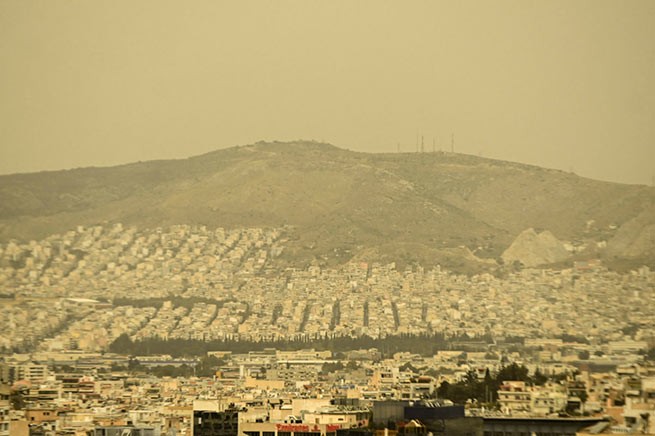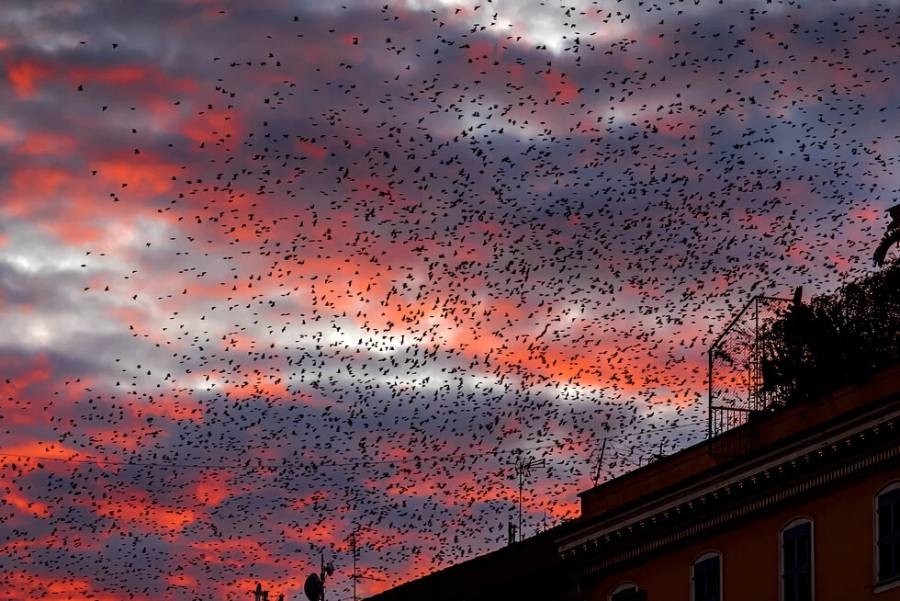At dawn, the sky of Rome is cobalt blue, and flocks of birds soaring into the sky create a spectacle of the approaching apocalypse.
Drawing unimaginable figures in the air and clearly distinguishable against the backdrop of urban infrastructure, flocks fly over historical monuments and modern buildings. The starlings seemed to be “raging”. Thousands, like a huge solid air mass, the birds “dive” and take off, unite and separate. The phenomenon causes spiritual awe among citizens and foreigners.
However, when the sun sets, the magic ends. Birds settle down for the night. Hordes of birds, often in the thousands, spend their nights perching on a tree, overloading and breaking branches. Cars, bus stops, shop windows and sheds, and even cultural monuments are covered with a thick layer of excrement.
“Dung is plentiful” (“Κόπρος σε αφθονία”), as the Rome Environmental Protection Agency writes in its starling report. As noted, the residents would prefer that the birds “remove the best of health to another place.” However, despite efforts to manage the problem, it is becoming clear that it is the starlings that have a clear priority in this “argument” compared to humans.
This time of year in Rome, it is a marvel to look at the sky. Just before sunset, starlings amass by the hundreds of thousands, performing an aerial dance.
But when the sun sets, the magic ends. The birds descend – and wreak havoc. https://t.co/ecgwZ6nziS pic.twitter.com/ZspPk4csz6
— The Washington Post (@washingtonpost)
This time of year in Rome, it is a marvel to look at the sky. Just before sunset, starlings amass by the hundreds of thousands, performing an aerial dance.
But when the sun sets, the magic ends. The birds descend – and wreak havoc. https://t.co/ecgwZ6nziS pic.twitter.com/ZspPk4csz6
— The Washington Post (@washingtonpost) January 26, 2023
“>January 26, 2023
“It is impossible to move so many birds to another place,” explains Alessandro Montemaggiori, an ornithologist at the Sapienza University of Rome. Starlings are one of the most common bird species in the world, but Rome stands out in Europe as one of the main places of their accumulation and habitat..
Birds have been migrating here every year since the 1920s due to the mild climate. Winter is getting “softer” as car traffic, paved surfaces and city lights make the city’s atmosphere a few degrees warmer.
Birds fly with such synchronicity that one of the leading British ornithologists, Edmund Silos, even talks about … telepathy.
Was sitting on top of Trajan’s Market, Rome watching that thing that starlings do #mumuration pic.twitter.com/49AEsu1BXL
Was sitting on top of Trajan’s Market, Rome watching that thing that starlings do #mumuration pic.twitter.com/49AEsu1BXL
— Dr Sophie Hay (@pompei79) November 28, 2015
“>November 28, 2015
However, in the end, the experts came to the conclusion that the “synchronous dance” of birds is not coordinated by the “leader” of the flock, but is caused by a microsecond chain reaction between individuals. According to Nobel Prize-winning physicist Giorgio Parisi, each starling interacts with six or seven others in close proximity. This is how the “figures” that the townspeople see in the sky are obtained.
A particularly beautiful murmuration of starlings captured in Piazza della Repubblica, Rome, in January 2022
[? ekapugach: https://t.co/VV2u98MxMb] pic.twitter.com/7Sr4LsqiKR
A particularly beautiful murmuration of starlings captured in Piazza della Repubblica, Rome, in January 2022
[📹 ekapugach: https://t.co/VV2u98MxMb] pic.twitter.com/7Sr4LsqiKR
— Massimo (@Rainmaker1973) December 5, 2022
“>December 5, 2022







More Stories
Easter: strange Easter eggs and souvlaki lamps
The Thirty Years of Olive War is over
Raisins: benefits of eating before bed